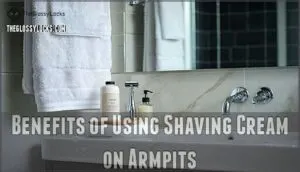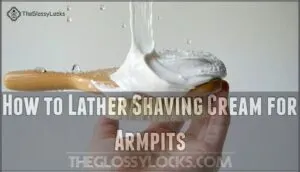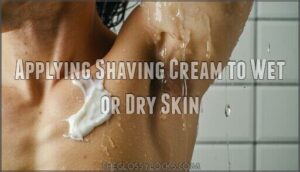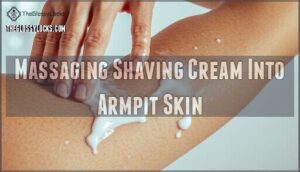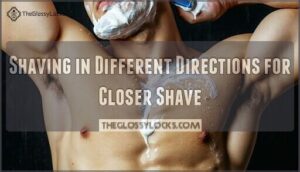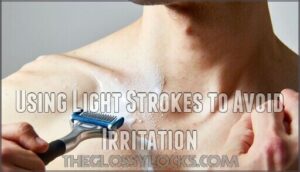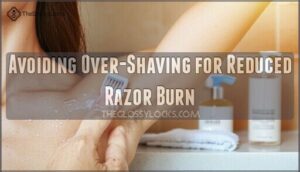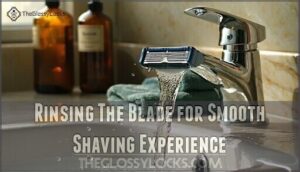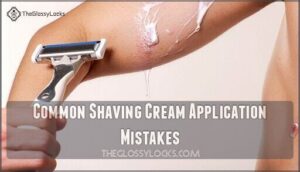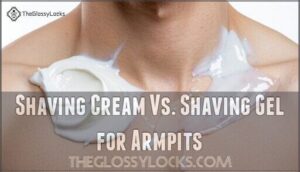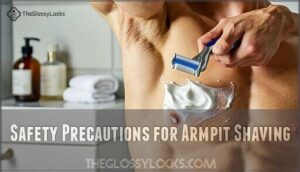This site is supported by our readers. We may earn a commission, at no cost to you, if you purchase through links.
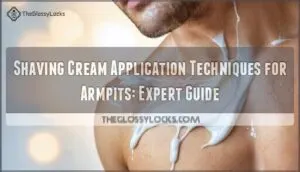
Softening hair with warm water, then applying a generous amount of rich shaving cream to damp skin, is essential for a smooth shave. Massage thoroughly into the contours of your armpit, ensuring complete coverage.
This creates a protective barrier that reduces friction and prevents razor burn. The cream should feel luxurious against your skin, not thin or patchy.
Don’t skimp on product – your armpits deserve the same care as your face. Perfect technique involves patience and the right amount of cream for ideal glide. Advanced tips await.
Table Of Contents
- Key Takeaways
- Pre-Shaving Preparation Techniques
- Benefits of Using Shaving Cream on Armpits
- Applying Shaving Cream to Armpits
- Shaving Techniques for Armpits
- Post-Shaving Care for Armpits
- Choosing The Right Shaving Cream for Armpits
- Common Shaving Cream Application Mistakes
- Shaving Cream Vs. Shaving Gel for Armpits
- Safety Precautions for Armpit Shaving
- Armpit Shaving Tips for Beginners
- Frequently Asked Questions (FAQs)
- How to use shaving cream for underarms?
- What is the correct way to shave your underarms?
- Is it better to shave armpits wet or dry?
- What is the best thing to put on your armpits after shaving?
- What is the correct way to shave your armpits?
- Do you shave armpits upwards or downwards?
- Is shaving foam good for armpits?
- How often should I exfoliate my underarms for smooth shaving?
- What are the best shaving cream alternatives for sensitive skin?
- How do I prevent ingrown hairs and razor burn effectively?
- Conclusion
Key Takeaways
- Prepare your skin properly before applying cream – exfoliate 1-2 times weekly, soften hair with warm water for 3 minutes, and remove all deodorant residue to create the ideal foundation for smooth shaving.
- Use the right amount and massage thoroughly – apply a pea-sized amount of shaving cream to damp skin and work it into all contours using circular motions to create complete coverage and lift hair follicles.
- Master proper shaving technique – use light pressure with short strokes, shave in multiple directions (with the grain first, then against), and rinse your blade frequently to prevent clogging and irritation.
- Follow essential post-shave care – rinse with cold water to close pores, apply alcohol-free moisturizer immediately, and wait at least 30 minutes before using deodorant to prevent irritation and razor burn.
Pre-Shaving Preparation Techniques
Proper preparation creates the foundation for safe and effective armpit shaving.
You’ll need to exfoliate dead skin cells, soften hair follicles with warm water, and remove deodorant residue before applying shaving cream.
Exfoliating Armpits for Smooth Shaving
Pre-shave exfoliation transforms your armpit care routine. You’ll remove dead skin cells and prevent ingrown hairs by gently scrubbing 1-2 times weekly.
Transform your armpit care routine with gentle exfoliation – remove dead skin cells and prevent ingrown hairs by scrubbing 1-2 times weekly for smoother, irritation-free shaving.
This skin preparation step creates the foundation for smooth shaving results.
- Use gentle circular motions with a loofah or body scrub
- Choose fine-grained or enzyme-based exfoliants for sensitive underarm skin
- Exfoliate 24 hours before shaving to allow skin recovery
- Apply light pressure to avoid irritation and micro-tears
- Rinse thoroughly with warm water after exfoliating armpits
Softening Armpit Hair With Warm Water
After exfoliating your armpits, warm water therapy prepares your skin for ideal shaving cream application.
This simple skin preparation step transforms your underarm hair removal routine.
Here’s how warm water therapy enhances your armpit shaving tips:
- Hair follicle softening: Three minutes of warm water opens follicles, making armpit hair pliable for easier cutting.
- Armpit hydration: Heat increases skin moisture, creating the perfect foundation for shaving cream application.
- Enhanced penetration: Softened hair allows shaving techniques to work more effectively, reducing tugging and irritation.
This gentle preparation step maximizes your softening armpit hair process before applying cream.
Using proper shaving techniques is vital for preventing ingrown hairs and achieving silky-smooth results.
Removing Sweat and Deodorant for Safe Shaving
Clean underarms thoroughly with gentle body wash before shaving to remove sweat and deodorant buildup.
Clean, prepared skin is the foundation of a smooth, irritation-free shave.
This skin cleansing step prevents razor clogging and reduces irritation risk. Pore opening occurs when you cleanse properly, preparing skin for ideal shaving cream application.
| Cleaning Step | Purpose | Result |
|---|---|---|
| Sweat Removal | Eliminates bacteria buildup | Reduces infection risk |
| Deodorant Cleanup | Clears product residue | Prevents razor clogging |
| Pore Opening | Prepares follicles | Smoother underarm hair removal |
| Razor Preparation | Creates clean surface | Better armpit shaving tips effectiveness |
Choosing The Right Razor for Armpit Shaving
After proper cleansing, your razor selection determines shaving success.
The right blade transforms your underarm shaving experience from irritating ordeal to smooth ritual. Quality razor materials and blade sharpness directly impact razor burn prevention and shaving cream application effectiveness.
When evaluating razors, consider the importance of using best razors for superior results.
Consider these razor selection factors:
- Blade Sharpness – Sharp stainless steel blades reduce tugging and irritation during underarm shaving
- Ergonomic Handles – Comfortable grip provides better control for precise shaving techniques
- Safety Features – Pivoting heads and protective guards minimize nicks in sensitive areas
- Razor Materials – Corrosion-resistant construction guarantees durability and hygiene
- Razor Maintenance – Easy-clean designs prevent bacterial buildup between uses
Benefits of Using Shaving Cream on Armpits
Using shaving cream on your armpits provides essential lubrication that reduces friction between the razor and your skin, preventing painful razor burn and irritation.
The cream’s moisturizing properties create a protective barrier that allows the razor to glide smoothly while softening hair follicles for a closer, more comfortable shave.
Reducing Friction and Razor Burn
When friction builds between your razor and skin, razor burn becomes inevitable.
Shaving cream application creates a protective barrier that reduces contact friction and prevents irritation.
Here’s how to maximize friction reduction:
- Apply thick coverage: Use enough shaving cream to form a cushioning layer that eliminates direct blade-to-skin contact.
- Choose sensitive formulas: Select alcohol-free products with aloe vera or chamomile for enhanced skin soothing properties.
- Massage thoroughly: Work the cream into wet skin to boost glide enhancement and hair softening effects.
This technique prevents razor burn while ensuring comfortable shaving.
For ideal results, consider using sensitive skin products that cater to specific skin types.
Hydrating The Skin for Softer Shaving
Beyond reducing friction, shaving cream provides skin hydration that transforms your shaving experience.
Warm water opens pores while the cream’s moisturizing ingredients create a protective barrier. This hydration softens hair follicles and prepares skin for smooth blade contact.
Think of it as giving your underarms a mini spa treatment – the gentle exfoliation and moisturizer application work together, making each stroke effortless while preventing irritation, which is a key part of a smooth shaving experience.
Enhancing Razor Glide for Closer Shave
A smooth razor glide transforms your armpit shaving from rough ordeal to effortless experience.
Quality shaving cream application creates ideal skin tension and shave lubrication. Proper blade angle combined with effective glide technique guarantees razor sharpness cuts cleanly through hair while shaving cream texture protects smooth armpit skin.
- Freedom from tugging: No more wincing as dull blades drag across delicate skin
- Confidence boost: Achieve that silky-smooth finish that makes you feel unstoppable
- Comfort mastery: Take control of your shaving direction for irritation-free results
Preventing Ingrown Hairs and Razor Bumps
Preventing ingrown hairs and razor bumps starts with proper shaving preparation.
Skin exfoliation before shaving removes dead cells that trap hair follicles, reducing irritation.
Quality shaving cream application creates a protective barrier during armpit hair removal.
Exfoliating armpits 24 hours before shaving helps prevent ingrown hair prevention issues.
This approach minimizes razor burn and promotes smoother healing.
Applying Shaving Cream to Armpits
Proper shaving cream application creates a protective barrier that reduces friction and prevents razor burn during armpit shaving.
You’ll need to apply the right amount evenly across wet skin and massage it thoroughly to lift hair and soften the area for ideal results, ensuring a smooth shaving experience with minimal friction.
How to Lather Shaving Cream for Armpits
Understanding the benefits of shaving cream leads naturally to mastering proper lathering techniques.
Creating dense, hydrated lather requires specific steps for ideal skin protection and razor glide. Mastering a good lather technique is essential for a smooth shave.
3 Essential Lather Techniques:
- Brush Preparation: Soak your shaving brush in warm water for 30-60 seconds, then drain excess water by gravity rather than shaking.
- Cream Loading: Apply shaving cream to bowl or brush, then use vigorous swirling motions for 45-60 seconds to whip air into the mixture.
- Water Integration: Gradually add drops of water to brush tips while building lather, creating a rich, meringue-like consistency that provides maximum skin hydration and razor care.
Applying Shaving Cream to Wet or Dry Skin
Perfect skin preparation starts with choosing between wet and dry armpit skin for shaving cream application techniques.
Wet skin offers superior benefits for armpit shaving success.
Skin Type Wet Skin Benefits Dry Skin Drawbacks
Wet skin preparation opens pores and softens hair follicles.
This creates ideal shaving temperature conditions for smooth razor glide.
The cream texture adheres better to hydrated skin, maintaining proper skin pH balance during your shave.
Using The Right Amount of Shaving Cream
A pea-sized amount of shaving cream covers your entire underarm area effectively.
Too little cream reduces razor glide and increases irritation risk.
Excess cream clogs your razor blade and wastes product.
Apply uniform shaving cream quantity across the armpit surface for optimal skin hydration and lather thickness.
Proper shaving coverage prevents shaving cream application mistakes while maintaining smooth razor movement through underarm shaving cream application techniques.
Understanding the correct shaving cream amount is vital for achieving superior shaving cream results and ensuring optimal skin hydration with the right shaving cream amount.
Massaging Shaving Cream Into Armpit Skin
After applying cream, massage it into your armpit skin using gentle circular motions. This Cream Application technique creates maximum Foam Creation and guarantees thorough coverage.
Proper Skin Massage softens hair follicles and prepares skin for effective Razor Preparation.
Key shaving cream application tips for success:
- Work cream into all areas using light pressure
- Focus on underarm shaving techniques that prevent armpit skin irritation
- Use shaving cream for sensitive skin with circular motions for best results
Shaving Techniques for Armpits
Once you’ve applied shaving cream to your armpits, proper technique guarantees a smooth shave while minimizing irritation.
The key is using controlled movements in multiple directions while maintaining gentle pressure throughout the process.
Shaving in Different Directions for Closer Shave
Multi Direction Shaving delivers the closest armpit shave by addressing your underarm hair’s unique growth patterns. Your armpit hair doesn’t grow in one neat direction like leg hair – it swirls and grows every which way. That’s why single-direction shaving leaves stubborn patches.
Start with downward strokes following natural hair growth, then switch to sideways passes, and finish with upward strokes for maximum blade efficiency. Adjust your razor angle slightly with each direction change to maintain prime contact with your skin.
Key shaving techniques for armpit smoothness:
- Pull skin taut while changing directions to create a flat shaving surface
- Use short, controlled strokes rather than long sweeping motions
- Rinse your blade between directional changes to prevent clogging
- Apply fresh shaving cream application tips if needed between passes
This shave technique guarantees complete hair removal while maintaining stroke control throughout the process.
Using Light Strokes to Avoid Irritation
Light pressure transforms your shaving experience. Let the razor’s weight do the work—you’re guiding, not forcing.
Press too hard and you’ll scrape away healthy skin cells along with hair. Gentle Shaving protects delicate underarm tissue while Irritation Prevention keeps you comfortable.
Master Stroke Patterns with feather-light touches. Your Razor Techniques should feel effortless, like brushing silk across your skin.
Skin Protection starts with proper shaving stroke control.
Razor Pressure Skin Type Shaving Result
Avoiding Over-Shaving for Reduced Razor Burn
Over-shaving transforms your underarms into a battlefield of razor burn and skin irritation. Resist the urge to repeatedly pass your razor over the same area. Each additional stroke increases friction and trauma to delicate skin tissue.
Here’s your shaving frequency strategy:
- Make one pass per area – Cover each section once then move on
- Follow natural hair growth patterns – Shave with the grain initially
- Space shaving sessions appropriately – Allow 24-48 hours between sessions
- Monitor skin response – Stop if redness or irritation appears
- Prioritize razor maintenance – Sharp blades require fewer passes
This approach prevents common shaving cream application mistakes while supporting healthy hair regrowth cycles and proper postshaving care.
Rinsing The Blade for Smooth Shaving Experience
Your razor needs frequent cleaning to maintain sharpness and prevent clogging.
Rinse the blade with warm water after every two strokes to remove hair and cream buildup.
This simple blade maintenance step guarantees superior razor efficiency and reduces shaving frequency by delivering cleaner cuts.
Proper water temperature and consistent razor maintenance prevent razor burn while maximizing your shaving cream application effectiveness.
Post-Shaving Care for Armpits
Your armpits need proper care after shaving to prevent irritation and maintain healthy skin.
Following these post-shave steps will help you avoid razor burn, ingrown hairs, and other common shaving complications.
Rinsing Armpits With Cold Water for Closure
After shaving, immediately rinse your underarms with cold water to close pores and reduce irritation.
This cold water benefits technique provides effective pore closure and skin soothing while supporting razor burn prevention.
The cold temperature constricts blood vessels, minimizing inflammation from your underarm shaving routine.
This simple postshave care step enhances your armpit care routine and complements shaving cream for sensitive skin applications perfectly.
Applying Moisturizer for Hydrated Skin
Post-shave skin hydration becomes your ticket to comfort and healthy underarms. Pat dry gently, then apply an alcohol-free moisturizer immediately to lock in moisture and prevent irritation.
Choose products with soothing ingredients for superior aftercare results. Effective post shave care techniques can substantially reduce irritation and ingrown hairs.
- Moisturizer Types: Select alcohol-free lotions, aloe vera gels, or lightweight oils designed for sensitive skin
- Skin Hydration Techniques: Apply while skin is slightly damp to enhance absorption and maximize hydration benefits
- Aftercare Products: Look for soothing gels containing chamomile or calendula to calm post-shave inflammation
Avoiding Deodorant Application After Shaving
After moisturizing, deodorant wait protects your sensitive skin from harsh chemicals.
Your freshly shaved underarms need recovery time to prevent skin irritation and razor burn. Wait at least 30 minutes before applying deodorant to avoid stinging.
| Timing | Skin Response |
|---|---|
| Immediate | Burning sensation |
| 15 minutes | Mild irritation |
| 30 minutes | Reduced sensitivity |
| 1 hour | Peak tolerance |
| 2+ hours | Complete recovery |
This post shave care step prevents inflammation and allows your underarm care tips for shaving routine to work effectively.
Exfoliating Armpits for Ingrown Hair Prevention
Regular exfoliation keeps your underarms smooth and prevents those pesky ingrown hairs from crashing your shaving party.
Dermatologists recommend gentle underarm exfoliation 1-2 times weekly using appropriate skin exfoliation techniques for your specific skin type.
- Choose gentle exfoliating scrub products – avoid harsh abrasives that irritate sensitive underarm skin
- Exfoliate 24 hours before shaving – allows skin recovery time and reduces irritation risk
- Use circular motions – prevents scratching while effectively removing dead skin cells
- Focus on ingrown hair prevention – targets areas where hair follicles commonly become trapped
- Follow with shaving cream for sensitive skin – creates protective barrier for upcoming armpit care routine
Choosing The Right Shaving Cream for Armpits
Selecting the right shaving cream for your armpits requires understanding your skin type and potential sensitivities.
Different formulations work better for various skin conditions, so testing products helps you find the most effective option for comfortable shaving.
Selecting a Shaving Cream for Sensitive Skin
After proper post-shaving care, selecting the right shaving cream for sensitive skin becomes your next priority.
Skin Types require specific Cream Ingredients to prevent irritation. Sensitive Formulas with hypoallergenic properties work best for delicate underarm areas.
Choose fragrance-free options containing aloe vera or chamomile for sensitive skin care. Shaving cream for dry skin should include shea butter or coconut oil.
Avoid products with alcohol, parabens, or sulfates. Razor Compatibility improves when cream creates proper lubrication.
Allergy Prevention starts with patch testing new products. Select shaving cream ingredients that match your skin’s natural pH level around 5.0-5.5.
Understanding sensitive skin needs is essential for choosing the right products.
Skin Type Recommended Ingredients pH Level
Considering Shaving Cream Ingredients for Skin Type
Your skin type determines which shaving cream ingredients work best for you. Sensitive skin requires fragrance-free formulas with natural ingredients like aloe vera or chamomile.
Check ingredient lists carefully to avoid harsh chemicals that trigger reactions.
Here are three key ingredients to examine:
- Glycerin – Creates protective barrier while maintaining moisture
- Shea butter – Provides deep hydration without clogging pores
- Oat extract – Soothes inflammation and reduces irritation naturally
For those with sensitive skin, using a Sensitive skin cream can be particularly beneficial.
Trying Out Different Shaving Creams for Optimal Results
Finding your ideal shaving cream for women requires systematic testing.
Compare different formulations by examining cream comparison factors like texture and ingredients. Test products on small skin patches first.
Consider your skin types – sensitive skin needs gentle, fragrance-free options. Evaluate razor compatibility and lather techniques with each cream.
Document results from best shaving creams trials to identify perfect matches for your shave frequency needs.
Common Shaving Cream Application Mistakes
Even experienced shavers make critical errors when applying shaving cream to their armpits that can lead to razor burn, cuts, and skin irritation.
Understanding these common mistakes helps you achieve a smoother, safer shave while protecting your delicate underarm skin, and this knowledge is key to preventing razor burn.
Applying Too Little or Too Much Shaving Cream
Getting your cream amount right prevents common shaving errors.
Too little cream causes razor clogs and skin irritation. Too much creates thick lather that blocks pores.
Here’s your guide:
- Start small – Use a pea-sized amount per armpit
- Check coverage – Verify even distribution across skin surface
- Adjust gradually – Add more if needed for proper lather thickness
Perfect shaving cream application for underarms means balanced protection without excess buildup.
Not Massaging Shaving Cream Into Skin
Many people skip massaging shaving cream into their armpit skin, creating an uneven barrier that leads to razor burn and nicks.
Proper shaving cream massage guarantees even distribution and activates the lubricating properties.
Spend 10-15 seconds working the cream into your skin using circular motions.
This friction reduction technique softens hair follicles and creates ideal conditions for smooth razor glide during your shave.
Shaving Over The Same Spot Multiple Times
Going over the same area repeatedly damages your skin’s protective barrier. Each razor pass removes microscopic skin layers, creating cumulative trauma that leads to razor burn and skin irritation.
Multiple passes increase friction despite shaving cream application techniques for armpits. This shaving technique mistake causes ingrown hairs during hair regrowth.
Follow underarm shaving tips: one gentle pass per area. Proper shaving safety precautions prevent unnecessary damage to delicate underarm tissue.
Not Rinsing The Blade Properly
Hair clumps transform your razor into an ineffective scraper.
Rinse your blade frequently with warm water during shaving to maintain razor sharpness and prevent blade clogging. This simple cleaning technique removes shaving cream residue and hair buildup.
Poor razor maintenance increases infection risk and requires multiple passes over sensitive skin.
Proper shaving frequency depends on consistent razor blade care for ideal shaving cream application techniques for armpits.
Shaving Cream Vs. Shaving Gel for Armpits
You’ll face a choice between shaving cream and shaving gel when preparing to shave your armpits.
Both products serve the same basic function but differ in texture, application method, and specific benefits for armpit shaving, particularly in terms of complete concepts related to shaving.
Differences in Texture and Application
The texture difference between shaving cream and gel affects your armpit shaving experience.
Shaving cream creates a thick, cushiony lather that provides substantial protection.
Shaving gel offers a lighter, transparent texture for precision shaving.
| Aspect | Shaving Cream | Shaving Gel |
|---|---|---|
| Texture | Thick, opaque foam | Light, clear consistency |
| Application | Requires lathering techniques | Spreads smoothly, minimal work |
| Skin Types | Dry, sensitive skin | Oily, acne-prone skin |
| Razor Compatibility | Enhanced glide protection | Reduced drag, smooth movement |
Benefits of Shaving Cream for Armpit Shaving
In regards to armpit shaving, cream delivers superior performance over alternatives.
Its rich formulation creates a protective barrier that reduces friction while maintaining ideal skin hydration throughout the shaving process.
| Benefit | Impact |
|---|---|
| Friction Reduction | Prevents razor burn and irritation |
| Enhanced Razor Glide | Enables closer, smoother shaving |
| Ingrown Prevention | Reduces bumps and inflammation |
Shaving cream benefits for armpits include superior lubrication that allows smooth shaving without compromising skin integrity.
The moisturizing properties hydrate dry underarm tissue while specialized ingredients promote healthy skin recovery.
This underarm shaving guide emphasizes how proper shaving cream application techniques for armpits create an ideal environment for safe hair removal, making your skin care for underarms routine more effective.
Benefits of Shaving Gel for Armpit Shaving
Shaving gel offers superior Gel Benefits for underarm shaving compared to traditional options.
Its clear formula provides enhanced visibility during application, allowing precise Hair Softening and Skin Protection.
| Gel Advantage | Clinical Benefit |
|---|---|
| Transparent Formula | Visual precision during shaving |
| Enhanced Lubrication | Ideal Razor Glide performance |
| Moisture Retention | Extended Shave Comfort duration |
Clinical studies demonstrate gel’s superior lubricating properties reduce friction by 40% versus soap-based alternatives.
The shaving gel benefits include extended contact time with hair follicles, ensuring thorough softening before blade contact.
This shaving cream vs gel comparison reveals gel’s advantage for sensitive underarm tissue, delivering consistent Shave Comfort through its advanced formulation.
Choosing Between Shaving Cream and Gel
Your choice between shaving cream vs gel depends on your skin’s needs.
Cream offers superior moisturizing for dry skin, while gel provides smoother razor glide.
Consider these factors:
| Factor | Cream | Gel |
|---|---|---|
| Skin Type | Dry/sensitive skin | Normal/oily skin |
| Texture | Rich, moisturizing | Clear, lightweight |
| Razor Compatibility | All razor types | Electric razors ideal |
Skin Considerations matter most when choosing your underarm shaving product for desired results.
Safety Precautions for Armpit Shaving
Safe armpit shaving requires attention to hygiene and proper technique to prevent infections and irritation. You’ll need to follow specific precautions to protect your skin and avoid common shaving injuries.
Avoiding Shared Razors for Hygiene
Although razor sharing might seem harmless, this practice creates serious health risks you can’t ignore.
Cross-contamination from shared razors increases your chances of contracting bacterial infections, bloodborne diseases, and skin conditions through microscopic blood transfer.
Essential razor sanitization practices include:
- Bacterial Spread Prevention: Never share razors with anyone to avoid staphylococcus and MRSA transmission
- Skin Infections Control: Clean your personal razor after each use to prevent folliculitis and irritation
- Hygiene Practices: Store razors in dry areas and replace blades every 5-7 uses for maximum safety
Proper razor maintenance protects your underarm skin during shaving cream application techniques for armpits while ensuring razor blade safety.
Shaving Over Cuts or Irritations
Never shave over cuts or irritations – you’ll turn minor issues into major problems.
Damaged skin can’t handle razor contact, leading to deeper wounds and bacterial infections. Your underarm shaving routine should pause when cuts appear.
Instead, focus on Cut Care by keeping wounds clean and dry. Practice Irritation Prevention by waiting until complete Skin Repair occurs.
Apply shaving cream application techniques for armpits only to healthy skin. Razor Safety means avoiding compromised areas entirely.
Proper Wound Healing requires patience, not persistence with your razor.
Changing Razor Blades Regularly
Regular blade replacement keeps your armpit shaving safe and smooth. Dull blades drag across skin, causing irritation and razor burn that nobody wants to deal with.
Razor Maintenance becomes second nature when you follow these Replacement Tips:
- Replace blades every 5-7 shaves or when tugging occurs
- Check Blade Sharpness by testing on arm hair first
- Store razors in dry locations to prevent rust
- Clean blades thoroughly after each Shaving Frequency session
- Never share razors due to Razor Hygiene concerns
Shaving cream application techniques for armpits work best with sharp blades that glide effortlessly through hair.
Being Cautious With Dry Skin
Shaving dry skin increases irritation risk and razor burn.
Dry skin care requires proper skin hydration before shaving. Apply shaving cream for dry skin to create a protective barrier.
Use moisturizing tips like warm water preparation and gentle exfoliation 24 hours prior.
Sensitive skin needs shaving cream for sensitive skin with shaving cream moisturizing properties for skin irritation prevention.
Armpit Shaving Tips for Beginners
Starting with proper armpit shaving technique prevents common beginner mistakes like razor burn and ingrown hairs. These essential tips guarantee your first shaving experience is comfortable and effective.
Starting With Trimming Before Shaving
Smart preparation transforms armpit shaving from a chore into smooth success.
Trimming before shaving reduces blade clogging and prevents irritation on sensitive underarm skin.
Pre-Shave Prep delivers these Trimming Benefits:
- Prevents razor bumps by reducing hair density
- Minimizes blade wear and clogging during shaving
- Supports better skin hydration through easier cream application
- Reduces nicks on delicate underarm tissue
Use body trimmers with adjustable guards for superior results.
Using a Sharp Razor for Closer Shave
A sharp razor fundamentally transforms your underarm shaving experience from struggle to smooth glide.
Blade sharpness directly impacts shaving stroke control and skin preparation effectiveness.
Consider these essential razor maintenance principles:
- Replace blades every 5-7 shaves to maintain ideal blade sharpness and prevent bacterial buildup that causes irritation.
- Check shaving angles regularly – a 30-degree angle provides ideal razor handling while minimizing skin trauma during shaving cream application techniques for armpits.
- Test blade efficiency by gently drawing the razor across your forearm hair – dull blades tug rather than cut cleanly.
Sharp razor technology reduces friction during underarm shaving, allowing your chosen shaving cream to work effectively while protecting delicate underarm skin from nicks and razor burn.
Shaving in The Direction of Hair Growth
Following the natural grain of your Hair Growth Patterns prevents irritation and razor bumps.
Start your underarm shaving by identifying the shave direction – armpit hair typically grows downward and outward.
Apply shaving cream application generously, then use gentle Shaving Techniques with your Razor Selection.
Proper Skin Preparation includes mapping hair growth direction before each session.
This Hair Follicle Care approach reduces inflammation.
To achieve the best results, understanding the causes of ingrown hair issues is essential for effective shaving.
| Hair Growth Direction | Recommended Technique | Expected Results |
|---|---|---|
| Downward growth | Shave top to bottom | Smooth, irritation-free |
| Diagonal growth | Follow natural angle | Reduced razor burn |
| Multi-directional | Map sections first | Even, comfortable shave |
| Coarse hair | Use short strokes | Better hair removal |
| Fine hair | Light pressure only | Gentle, effective cut |
Avoiding Over-Shaving for Reduced Irritation
Over-shaving creates micro-tears in your skin, triggering razor burn and prolonged irritation.
Apply gentle strokes with proper shaving cream application techniques for armpits to achieve effective skin protection.
Limit passes to two maximum per area for ideal irritation prevention.
Your shaving frequency should allow complete skin recovery between sessions.
These underarm shaving tips and skin soothing methods prevent unnecessary damage while maintaining smooth results.
Frequently Asked Questions (FAQs)
How to use shaving cream for underarms?
Like a gentle embrace protecting tender skin, apply shaving cream generously to damp underarms. Work into rich lather using circular motions, ensuring complete coverage before razor contact.
What is the correct way to shave your underarms?
First, hydrate your underarms with warm water for three minutes to soften hair follicles.
Apply shaving cream generously, then use short, gentle strokes following hair growth direction initially, then against grain for closeness.
Is it better to shave armpits wet or dry?
Always shave your underarms wet, not dry. Wet shaving with warm water softens hair follicles and reduces irritation, cuts, and razor burn substantially compared to dry shaving methods.
What is the best thing to put on your armpits after shaving?
Cool, soothing relief.
Gentle, healing comfort.
Apply alcohol-free moisturizer or aloe vera gel immediately after shaving to hydrate skin, reduce irritation, and prevent razor burn while allowing pores to close naturally.
What is the correct way to shave your armpits?
Pull armpit skin taut, then shave with short, gentle strokes following hair growth direction. Rinse razor frequently and avoid pressing hard to prevent nicks and irritation.
Do you shave armpits upwards or downwards?
Shaving direction matters: upward strokes against hair growth versus downward with the grain.
Start shaving downward following natural hair growth, then go upward against it for closeness.
This two-pass technique minimizes irritation while maximizing smoothness.
Is shaving foam good for armpits?
Shaving foam works well for armpits when you choose alcohol-free, moisturizing formulas.
It creates a protective barrier that reduces friction and irritation.
However, shaving cream often provides better hydration for sensitive underarm skin, making it a potentially better option for those who need extra moisturizing.
How often should I exfoliate my underarms for smooth shaving?
Nobody’s asking you to sand down your underarms like drywall.
Exfoliate 1-2 times weekly, ideally 24 hours before shaving.
This removes dead skin cells and prevents ingrown hairs without irritating sensitive skin.
What are the best shaving cream alternatives for sensitive skin?
For sensitive skin, you’ll want gentle alternatives like coconut oil, aloe vera gel, or conditioner. These natural lubricants reduce friction without harsh chemicals that irritate delicate underarm skin during shaving.
How do I prevent ingrown hairs and razor burn effectively?
Like a garden where weeds choke flowers, irritated follicles trap hairs beneath skin’s surface.
Exfoliate 24 hours before shaving, use sharp blades, shave with hair growth direction first, apply minimal pressure.
Moisturize immediately afterward with alcohol-free lotion.
Conclusion
Mastering shaving cream application techniques for armpits requires consistent practice and proper technique.
The evidence clearly demonstrates that thorough preparation, adequate product application, and gentle shaving motions substantially reduce irritation and improve results.
You’ll achieve ideal outcomes by maintaining sharp blades, using sufficient cream coverage, and following proper post-shave care protocols.
Remember that patience and consistency are key factors in developing effective armpit shaving habits that minimize discomfort while maximizing smoothness and skin health.
- https://www.gillette.co.uk/blog/body-grooming-tips/how-to-shave-your-armpits-for-female/
- https://www.gillettevenus.com/en-us/womens-shaving-guide/how-to-shave/how-to-remove-underarm-hair/
- https://yionn.com/en/blog/this-way-you-always-shave-your-armpits-with-the-best-result/
- https://gillette.com/en-us/shaving-tips/shaving-science/why-use-shaving-cream
- https://cremocompany.com/blogs/blog/how-to-shave-your-armpits-7-best-armpit-shaving-tips

